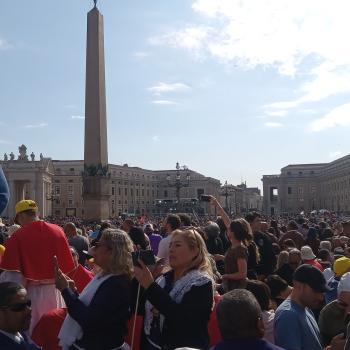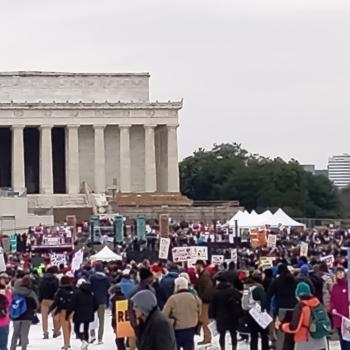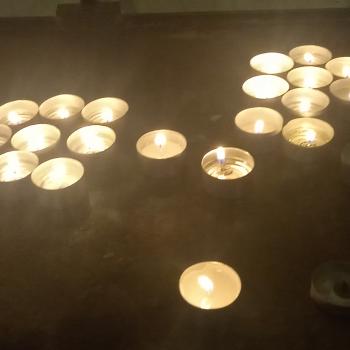In a recent post at In All Things, the blog of America Magazine, Tom Beaudoin asks the provocative question: “What if ‘Occupy Wall Street’ could be attempted in the Catholic Church?” What could lead to such a movement in the Catholic Church? He muses on the reasons in the following way:
Or, like the “Occupy Wall Street” movement, would the precipitating awareness that would lead you to join such a movement simply be a recognition of the intractibilty of the the near invisibility, in everyday church governance, of the overwhelming majority (all non-ordained persons) as compared to the small minority (the ordained)?
At Mirror of Justice, on October 10, a Jesuit, Fr. Robert Araujo, SJ, responded:
Did it occur to him that the teachings of the Church are not designed to reflect what any society appears to want at any given time? Still, he imaginatively pits the “overwhelming majority (all non-ordained persons)” against “the small minority (the ordained).” I happen to be in the latter category, but I find the reality of being one of the ordained unlike the broad characterization offered by Professor Beaudoin does not pit me against those whom I am called by my particular vocation to serve.
Having served on most weekends in local parishes for the last eighteen years since my ordination, I don’t find myself or the other clergy with whom I labor being pitted against the faithful. Rather, what I have found and continue to find in parishes across the country is that the People of God, the Body of Christ, whom I encounter, come together to pray, to celebrate and receive the sacraments, and ask God to help us reinforce our faith so that we may be worthy disciples of His Son. I do not see anyone from either segment of the Church as Professor Beaudoin describes it, “Looking at the world and the church in this moment” and declaring “that now may be some kind of privileged time for [OWS] action.” Beaudoin asks in oratorical fashion: “Will Catholics take it [i.e., OWS action] up?”
Why should they, for most of the faithful, be they clergy or laity, have what they seek in the Church as she has existed, as she continues to exist, and as she will exist: guiding and perfecting their way on the human destiny of union with God. The Church is not a political event; rather, it is a divine institution established to bring salvation to those who, in spite of our sinfulness, chose the standard of Christ.
Nevertheless, although Fr. Araujo claims that ” I don’t find myself or the other clergy with whom I labor being pitted against the faithful,” the fact of the matter is that Fr. Araujo’s parish is full of so-called “cafeteria Catholics” who don’t “have what they seek in the Church” as she is. The same is true in almost every parish in the United States. Let’s take, for example, Church teaching on birth control and women’s ordination. In 2005, 75% of faithful church-going Catholics polled said that you can be a good Catholic and not accept Church teaching on birth control. Even among the “high commitment” Catholics polled (those who said they would never leave the Catholic Church), 64% agreed that you can be a good Catholic and not accept the Church’s position on this issue. Only 44% consider a celibate male clergy to be important, and 61% said that it would a good thing to ordain women as priests. Among priests, in 2002, only 27% of priests said that contraception was “always wrong.” 50% support the ordination of women as priests, and 40% the ordination of women as bishops. This is despite the fact that these teachings are considered “definitive” by the Catholic Church. So either there is a serious crisis of authority in the Catholic Church in the United States. Or, the faithful, both clerical and lay, are beginning to take seriously their own sensus fidei, their own sense of the truth content of the faith. While there is an external veneer of agreement and unity that Fr. Araujo notices, the fact of the matter is there on certain contentious matters there is no agreement.
So can you occupy the Catholic Church? Well, yes and no. Yes, in the sense that “cafeteria Catholics” already do. On all hot topic Church issues, the majority of faithful Catholic’s polled chose “themselves” over “Church leaders” and “both” as the authroity they look to regarding questions of human sexual morality. So most American Catholics are “cafeteria Catholics.” The pejorative term, “cafeteria Catholicism,” though, has several meanings. After reading Jerome Baggett’s book The Sense of the Faithful, I will place “cafeteria Catholics” in three categories. He interviewed 300 parishioners in the diocese of San Francisco to flesh out the sociological data of recent years, and (using pseudonyms) offers us three examples:
First, Sandra Badillo, a parishioner at traditional (Latin Mass) St. Margaret Mary who disparages the “wishy-washiness” of cafeteria Catholicism, herself disagrees with the Church’s teaching on contraception. She justifies her disagreement by labeling it as “private dissent” that she would never bring to a public forum.
Sarah Henslin, a “liberal with a capital L,” also resists the label of cafeteria Catholic. She does not just make her decisions for the sake of convenience. Rather, she discerns and struggles to utilize personal agency in a proper allocation of the teachings and symbols offered her by the Catholic tradition.
Finally, in the third category are those who embrace cafeteria Catholicism since it has the advantage of whetting “people’s appetites for more,” as Elaine Gaskill explains. Thus, many Catholics who are often disparagingly accused of cafeteria Catholicism are actually quite respectful of the tradition and are selective only insofar as they are unwilling to blindly believe what they do not understand, thereby taking seriously their own sensus fidei.
It is only the third category that is rather flippant about the term. The rest of us generally fall under the first two categories of cafeteria Catholics. Sandra values the teaching office of the Church and refuses to dissent publicly, but she does have internal disagreements with Church teaching. Sarah is much more public. But even Sandra is a cafeteria Catholic since according to the Catholic Profession of Faith, each Catholic must “adhere with religious submission of will and intellect to the teachings which either the Roman Pontiff or the College of Bishops enunciate when they exercise their authentic Magisterium, even if they do not intend to proclaim these teachings by a definitive act.” And Canon 750.2 states that “one who refuses those propositions which are to be held definitely is opposed to the doctrine of the Catholic Church.”
Conversely, however, Canon 750.1 also contains an addition from the 1917 code by stating that a person must believe everything in the “deposit of faith” entrusted to the Church whether proposed as “divinely revealed” or as transmitted by the “solemn magisterium of the Church” or “by its ordinary and universal magisterium which ismanifested by the common adherence of the Christian faithful under the leadership of the sacred magisterium.” This is a nod to the teaching of Vatican II on the sensus fidelium in LG 15:
The holy people of God shares also in Christ’s prophetic office; it spreads abroad a living witness to Him, especially by means of a life of faith and charity and by offering to God a sacrifice of praise, the tribute of lips which give praise to His name. The entire body of the faithful, anointed as they are by the Holy One, cannot err in matters of belief. They manifest this special property by means of the whole peoples’ supernatural discernment in matters of faith when “from the Bishops down to the last of the lay faithful” they show universal agreement in matters of faith and morals. That discernment in matters of faith is aroused and sustained by the Spirit of truth. It is exercised under the guidance of the sacred teaching authority, in faithful and respectful obedience to which the people of God accepts that which is not just the word of men but truly the word of God. Through it, the people of God adheres unwaveringly to the faith given once and for all to the saints, penetrates it more deeply with right thinking, and applies it more fully in its life.
Ormond Rush has done perhaps the most thorough job of explaining this teaching in his book The Eyes of Faith. He concludes that there is one and only one sensus fidelium, shared by magisterium, theologians, and the faithful alike. Insofar as Vatican II also assigned the prophetic office to all, there is also only one teaching office and teaching authority that has been given to all. Of course, as the hierarchical teaching authority, the magisterium has a special role to play in preserving the faith. After an excellent analysis of the sensus fidei at work in each individual, whether Bishop or layperson, Rush concludes by listing the triad of voices within the sensus fidelium that he calls the sensus laicorum, the sensus theologorum, and the sensus episcoporum. It is the interaction between these three that will be the continued challenge in the future for a continued rich discussion of the doctrine of the sensus fidelium.
However, the precise nature of the sensus fidelium is difficult to nail down. The CDF Instruction on the Vocation of the Theologian explains:
35. Dissent sometimes also appeals to a kind of sociological argumentation which holds that the opinion of a large number of Christians would be a direct and adequate expression of the “supernatural sense of the faith”.
Actually, the opinions of the faithful cannot be purely and simply identified with the “sensus fidei”.(31) The sense of the faith is a property of theological faith; and, as God’s gift which enables one to adhere personally to the Truth, it cannot err. This personal faith is also the faith of the Church since God has given guardianship of the Word to the Church. Consequently, what the believer believes is what the Church believes. The “sensus fidei” implies then by its nature a profound agreement of spirit and heart with the Church, “sentire cum Ecclesia”.
Although theological faith as such then cannot err, the believer can still have erroneous opinions since all his thoughts do not spring from faith.(32) Not all the ideas which circulate among the People of God are compatible with the faith. This is all the more so given that people can be swayed by a public opinion influenced by modern communications media. Not without reason did the Second Vatican Council emphasize the indissoluble bond between the “sensus fidei” and the guidance of God’s People by the magisterium of the Pastors. These two realities cannot be separated.(33) Magisterial interventions serve to guarantee the Church’s unity in the truth of the Lord. They aid her to “abide in the truth” in face of the arbitrary character of changeable opinions and are an expression of obedience to the Word of God.(34) Even when it might seem that they limit the freedom of theologians, these actions, by their fidelity to the faith which has been handed on, establish a deeper freedom which can only come from unity in truth.
What may appear problematic with this explanation is that it makes it difficult to understand the concrete way in which the sensus fidelium can be expressed. This in turn is what leads us back to Tom’s question.
In a democratic society, the government is guided not by the Holy Spirit in reflection upon a “deposit of faith,” but by good will and the consent of the people. The Church is not this way. So the only purpose that an OWS movement could have within the Church would be to express to the Church a desire for greater reflection upon an issue. And indeed, although the sensus fidelium is not based on “sociological argument,” the birth control commission of Paul VI, though it ended up ignoring the majority opinion of Catholic theologians and lay couples, did seek out their opinion, considering it important in helping the pope to accurately “discern” the authentic teaching. Even the pope doesn’t just “know” the teaching. He must seek it out.
On the other hand, so-called “cafeteria Catholicism” cannot be ignored. The Donatist heresy did not carry the day. The Church is not a church of the “saints” in the sense of a Church of the “perfect.” The majority of priests, lay Catholics, and, dare I say it, even many bishops, are not in keeping with true Catholic doctrine. Yet they have a place in the Church. Would a priest really want to interview each of his parishioners and kick out all of those who he deemed to be “cafeteria Catholics?” He would have no one left.
So while Tom’s position misconstrues the nature of authentic theological development in the Catholic Church, he puts his finger on the seemingly nebulous and contentless nature of the Catholic teaching of the sensus fidelium. Conversely, Fr. Araujo does not seem to want to admit that there is a tremendous amount of disagreement today between American lay Catholics and many of their priests and bishops, claiming that most Catholics “have what they seek in the Church.”
It seems to me that the answer to this problem can only be in a far more detailed theological examination of the methodology of the reception of the “deposit of the faith” that also includes the lay faithful. Such a theological methodology would begin by admitting that, while the Bishops are the authentic teachers of the faith, all baptized Catholics share the privilege of being authentic receivers of the faith. It would be to encourage an analysis of a new theological method rather than to attempt to change a doctrine that a Catholic OWS movement would have to be aimed. To compromise the magisterium of the Church led by the Holy Spirit would be to compromise what makes the Catholic Church what it is. I don’t believe that Tom thinks that a new Reformation — which is precisely what a direct importation of the OWS movement into the Catholic Church would look like — is what we need.












